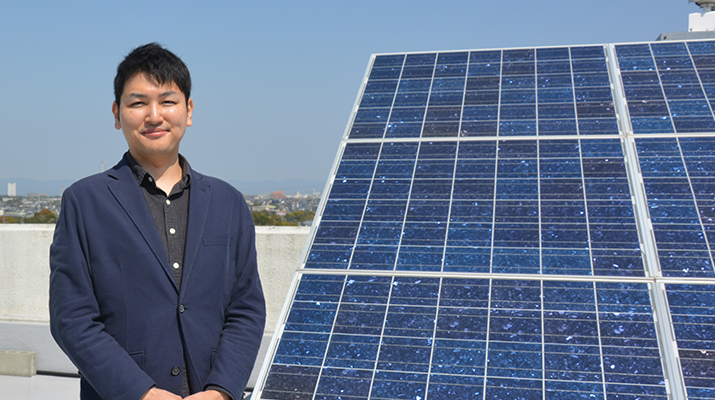
ここからコンテンツです。

Ultra-high-rate plasma coating to improve surface function
Reduces friction and extends product life Toru Harigai
A Toyohashi University of Technology research team, led by lecturer Toru Harigai, have developed an ultra-high-rate coating technology for functional hard carbon films using vacuum plasma. Functional hard carbon films with low friction coefficients are used as protective films with sliding surfaces. This technology has achieved a film deposition rate of more than one order of magnitude faster than existing coating technologies, while maintaining the same degree of film quality. The technology—which can be introduced using a unique gas injection method and simple equipment configuration—can be expected to be applied in improving the functional performance of general-purpose products and other mass-produced products.
Diamond-like carbon (DLC) is a hard carbon film material with various functions such as high biocompatibility and oxygen impermeability. It is widely used in sliding parts of tools and automobiles, especially as a functional protective coating material that protects the surface of the base material while at the same time imparting sliding properties (slipperiness) to the base material due to its low friction coefficient. This hard carbon film can only be synthesized by vacuum plasma technology. Since the deposition rate for existing technologies is a few 100 nm/min, there are few advantages in terms of cost effectiveness to apply to mass-produced products, and they have mainly been applied to high added-value products. Additionally, since there is essentially a trade-off between the hardness of the film and the deposition rate, the development of technologies that improve deposition rate while maintaining the hardness (quality) of films is desirable from an applied engineering standpoint.
The research team proposed a unique gas injection method in which two kinds of gas were ejected in a jet shape and mixed in a vacuum, and achieved ultra-high-rate film formation for hard carbon films exceeding the deposition rate for existing techniques by more than one order of magnitude, with a plasma deposition device utilizing this gas injection method. By achieving ultra-high-rate film formation through this gas injection method, the team has removed the need to form a complex discharge electrode in or around the object being coated, so it can be expected to be used as a highly versatile process that can be applied to a diverse range of materials and shapes.

In the initial stages of the research, problems such as carbon film adhesion in unintended places and clogging of the gas exhaust system due to large amounts of dust occurred due to the generation position and expansion of the plasma, and the desired results of hard film formation and improved deposition speed were not obtained. By making multiple improvements to the equipment based on the knowledge obtained through a process of trial and error, ultra-high-rate film formation exceeding a rate of 2µm/min was eventually achieved through plasma generation utilizing the team's unique gas injection method. This technology is based on the combination of gases and well-known existing techniques for the formation of plasma, which forms the basis for film formation. In combining these techniques, the team was able to create an environment that is very different locally from the existing methods. As a result, they could obtain new results that surpassed the need for the trade-off between film hardness and deposition speed which had previously been considered unavoidable.
The research team plans to expand the size of the high-speed deposition area to improve the practical applications of equipment utilizing this technology. They believe that coating of cylindrical inner walls and complex structures will eventually become possible through further research and development. In the future, they hope to achieve the widespread adoption of this new coating technology. In doing so, they hope to contribute to the creation of a society capable of sustainable development, by improving energy consumption through the application of the superior sliding properties of hard carbon films.
This research was conducted with the support of the Osawa Scientific Studies Grants Foundation.
Reference
Toru Harigai, Hikaru Ohhra, Ryoya Tominaga, Takahiro Bando, Hirofumi Takikawa, Shinsuke Kunitsugu, and Hidenobu Gonda. "Ultra-high-rate deposition of diamond-like carbon films using Ar/C2H2 plasma jet CVD in combination with substrate-stage discharge",Japanese Journal of Applied Physics (2022).
10.35848/1347-4065/ac54f8
新たな機能を付与するプラズマ超高速コーティング
摩擦を減らし、製品寿命を延ばす針谷 達
豊橋技術科学大学の針谷達講師らの研究チームは、真空プラズマを用いた機能性硬質炭素膜の超高速コーティング技術を開発しました。低摩擦係数を有する機能性硬質炭素膜は、摺動性表面保護膜として利用されており、本技術は、従来コーティング技術に対し、同程度の膜質を維持したまま、一桁以上速い成膜速度を達成しました。独自のガス導入法と簡易な装置構成により導入可能な本技術は、汎用品など大量生産品の機能性向上に適用可能な技術として期待できます。
高い生体適合性や酸素不透過性など多様な機能を有するダイヤモンドライクカーボン(Diamond-like carbon:DLC)とよばれる硬質炭素膜は、特に低摩擦係数材料として母材へ摺動性(滑りやすさ)を付与しつつ、母材表面を守る機能性保護コーティング材料として、工具や自動車の摺動部品などに広く用いられています。この硬質炭素膜は、真空プラズマ技術によってのみ合成が可能です。従来技術の成膜速度は、数100nm/min程度であるため、大量生産品へ適用するには費用対効果の点でメリットが少なく、主に高付加価値製品に適用されてきました。また、膜の硬さと成膜速度は、基本的にトレードオフの関係にあるため、応用的観点から、膜の硬さ(膜質)を維持しつつ、成膜速度を向上させる技術の開発が望まれています。
そこで、本研究チームは、2種類のガスをジェット状に噴出し、真空中で混合する独自のガス導入法を提案し、このガス導入法を用いたプラズマ成膜装置を用いて、従来の成膜速度を一桁以上上回る炭素硬質膜の超高速成膜を実現しました。ガスの導入法により超高速成膜を実現したことで、被成膜物自体またはその周囲に、複雑な放電電極を形成する必要がないことから、多様な材質や形状などに適用可能な汎用性の高いプロセスとして期待できます。
研究当初は、プラズマの生成位置や拡がりが原因となり、意図しない場所への炭素膜付着や大量のダスト発生によるガス排気系の目詰まりなどの問題が生じ、なかなか硬質かつ成膜速度の向上という結果を得られませんでした。トライアンドエラーの繰り返しで得られた知見に基づいて複数回の装置改良を経ることで、独自のガス導入法を用いたプラズマ生成法により、2µm/minを超える超高速成膜を実現しました。本技術は、ガスの組み合わせや、基本となるプラズマの生成技術は、従来のよく知られた手法です。それらの構成の中で、局所的に従来法とは大きく異なる環境を作り出すことで、これまでの常識であった膜の硬さと成膜速度のトレードオフの関係を崩す、新たな結果を得ることができました。
研究チームは、本技術を適用した装置の実用化に向けて、高速成膜エリアの拡大に取り組んでいく予定です。今後の研究開発によって、円筒内壁や複雑構造物へのコーティングも可能であると考えています。将来的には、新たなコーティング技術として広く普及させ、硬質炭素膜の持つ優れた摺動性によるエネルギー消費の改善などによって、持続的発展の可能な社会の実現にも役立ていきたいと考えています。
Researcher Profile

| Name | Toru Harigai |
|---|---|
| Affiliation | Department of Electrical and Electronic Information Engineering |
| Title | Lecturer |
| Fields of Research | Plasma Processing / Carbon Nanomaterials / Renewable energy |
ここでコンテンツ終わりです。
